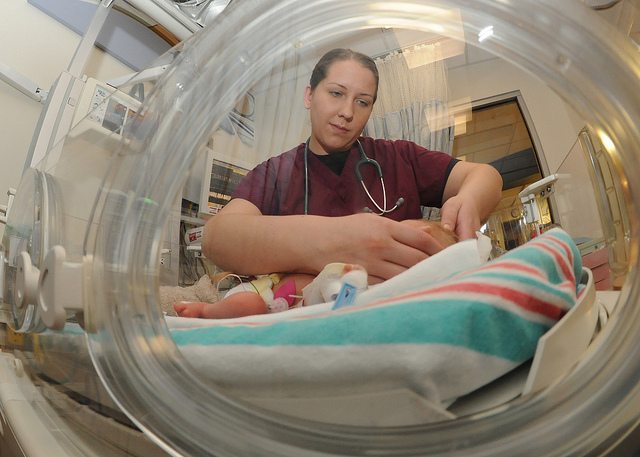Umbilical Cord Prolapse and Compression
Umbilical cord prolapse and compression are both umbilical cord complications associated with labor and delivery. Before we discuss the risks, causes, and injuries associated with prolapsed and compressed cords, let’s first outline some basic definitions:
- Umbilical cord prolapse: When umbilical cord prolapse occurs, the umbilical cord falls into the vagina ahead of the baby during delivery. The two types of prolapsed umbilical cords include the following:
- Overt prolapse: The umbilical cord leaves the cervix or vagina before the medical practitioner can see or feel the baby. An overt prolapse is the most common kind of umbilical cord prolapse.
- Occult prolapse: The umbilical cord descends alongside, but not past, the presenting part of the baby (the part of the baby that enters the birth canal first). It may occur when the amniotic sac and chorion are intact or ruptured.
- Umbilical cord compression: Umbilical cord compression occurs when the umbilical cord is constricted and squeezed between the baby’s body and the uterus, cervix, or pelvis during delivery.
Since the umbilical cord carries oxygen, blood, and nutrients from the placenta to the baby, any disruption to its placement or function can lead to serious injuries such as birth asphyxia (hypoxic ischemic encephalopathy) or cerebral palsy (CP).
Did umbilical cord prolapse or compression lead to your loved one’s permanent injury or cerebral palsy (CP)? If so, you may have grounds for a medical malpractice claim. Contact Michigan Cerebral Palsy Attorneys today and our Michigan birth injury lawyers will answer your questions and provide you with a free case review. You may contact our umbilical cord prolapse and compression attorneys 24/7 by calling our office toll-free at (888) 592-1857, filling out this online contact form, or pressing the Live Chat tab to the left.
What Injuries Are Associated with Umbilical Cord Prolapse and Compression?
Umbilical cord prolapse and compression can cause sudden and potentially severe limitations in the supply of oxygenated blood from the placenta to the baby through the umbilical cord. It can cause blood vessels to spasm (vasospasm) and decreases in cord temperature, both of which limit oxygenated blood to the baby.
What Causes Umbilical Cord Prolapse and Compression?
 Premature rupture of membranes (PROM): PROM is the most common cause of prolapsed and compressed umbilical cords. If a physician artificially ruptures the maternal membranes before the baby is in the proper position in the pelvic inlet, the fluid loss and position of the baby’s head in the cervix allows the umbilical cord to go before the baby and become compressed.
Premature rupture of membranes (PROM): PROM is the most common cause of prolapsed and compressed umbilical cords. If a physician artificially ruptures the maternal membranes before the baby is in the proper position in the pelvic inlet, the fluid loss and position of the baby’s head in the cervix allows the umbilical cord to go before the baby and become compressed.- Malpresentation: Unusual presentation of the baby (like the breech presentation) may allow space for the umbilical cord to fall through the birth canal before the baby’s body.
- Premature delivery
- Multiple gestation: For mothers carrying more than one baby, the first baby may push out the cord of another baby before exiting the mother.
- Abnormally long umbilical cord length
- Polyhydramnios (excessive amniotic fluid)
What Are the Signs and Symptoms of Umbilical Cord Prolapse and Compression?
The most obvious sign of a prolapsed cord is being able to see or feel the cord before the baby is delivered. Another sign includes fetal distress from lack of oxygen, as evidenced by the fetal heart rate monitor. In order to anticipate the condition, physicians should be on the lookout for the aforementioned causes of prolapsed and compressed umbilical cords. However, if cord prolapse and compression become present during delivery, medical professionals must act swiftly and skillfully to prevent damage to the baby.
How Is a Prolapsed Umbilical Cord Treated?
To avoid lasting injury from a prolapsed umbilical cord, physicians must rapidly assess the presence of the condition and intervene. The following treatments may lower the chance of prolapsed cord injury:
- Emergency C-section: Emergency Cesarean section deliveries are often necessary, so physicians must be prepared.
- Pressure relief on cord: Physicians can move the baby away from the cord to lessen pressure on it and reduce risk of oxygen deprivation.
- Delivery assistance tools: Forceps and vacuum extractors are commonly used to reduce the risk of oxygen loss during vaginal delivery.
Legal Aid for Prolapsed Umbilical Cord Injuries, Umbilical Cord Compression Injuries, and Cerebral Palsy
Umbilical cord prolapse and compression present difficult and dangerous delivery situations, and medical professionals are obligated to handle them both skillfully and quickly. Unfortunately, newborns may suffer lasting injuries in these deliveries from medical negligence.
For reference, the following scenarios reflect negligence on the part of a medical professional:
- Failure to detect or assess the various signs, symptoms, and risk factors for a prolapsed cord.
- Failure to order and perform an emergency C-section during a delivery where fetal distress is evident
- Failure to inform the mother of the risks or alternative delivery options for a prolapsed or compressed umbilical cord
If your child was diagnosed with cerebral palsy as a result of umbilical cord prolapse and compression and you believe medical professionals violated the standard of care in one or more of these ways, call us. We’ll determine if you have grounds for a medical malpractice case. Contact our Michigan office at (888) 592-1857.
